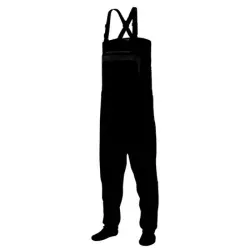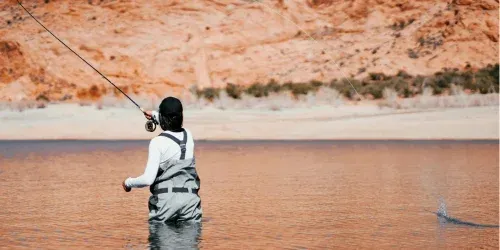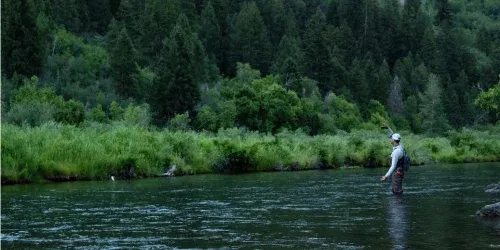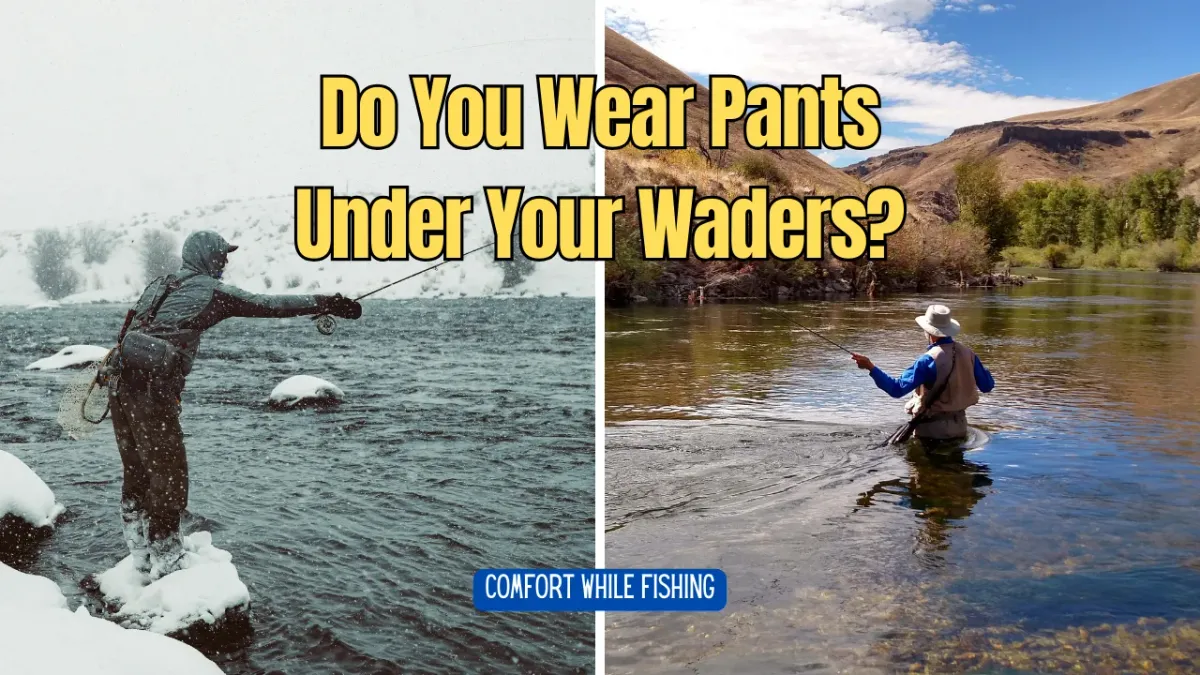Chest waders are essential gear for anglers, providing protection and comfort while fishing in various water conditions. Choosing the right material for fishing waders can make a significant difference in your fishing experience. With so many options available, it can be challenging to determine the best material for your needs. This article will explore the different materials used in chest waders, their benefits, and how to choose the right one for your fishing adventures.
Key Takeaways:
- Material Matters: The choice of material for chest waders significantly impacts comfort, durability, and suitability for different fishing conditions.
- Types of Waders: Understanding the different types of waders, such as breathable waders, neoprene waders, and nylon waders, helps in making an informed decision.
- Personal Preference: The best material for chest waders often depends on personal preference, fishing environment, and specific needs of the angler.

The Importance of Material in Chest Waders
The material of your chest waders plays a crucial role in their performance. It affects everything from durability and comfort to breathability and insulation. Different materials offer varying levels of protection against water, cold, and wear and tear. Understanding the pros and cons of each material can help you make an informed decision and ensure you have the best waders for your fishing needs.

Neoprene Waders: The Warmth Factor
Neoprene waders are a popular choice among anglers, especially for fishing in colder waters. Neoprene is a synthetic rubber material known for its excellent insulating properties. It comes in various thicknesses, typically ranging from 3mm to 5mm, providing varying levels of warmth. Thicker neoprene waders are ideal for cold weather, while thinner options are suitable for warmer temperatures.
Neoprene waders are also highly durable and resistant to punctures and abrasions. However, they can be less breathable than other materials, making them less comfortable for extended periods in warmer weather. Despite this, many anglers prefer neoprene waders for their warmth and durability, especially when fishing in colder climates.
Breathable Waders: Comfort and Versatility
Breathable waders are made from materials like Gore-Tex, which allow moisture to escape while keeping water out. This makes them an excellent choice for anglers who spend long hours in the water, as they help prevent overheating and discomfort. Breathable waders are particularly popular for fly fishing, where anglers often wade in shallow water for extended periods.
These waders are typically lighter and more comfortable than neoprene waders, making them suitable for warmer weather. However, they may not provide the same level of insulation in colder conditions. Many anglers opt for breathable waders with multiple layers to balance comfort and warmth, making them a versatile choice for various fishing environments.
Nylon Waders: Lightweight and Affordable
Nylon waders are another popular option, known for their lightweight and affordable nature. They are often used by traveling anglers who need a compact and easy-to-pack option. Nylon waders are typically less expensive than neoprene and breathable waders, making them a good choice for beginners or those on a budget.
While nylon waders may not offer the same level of durability or insulation as neoprene or breathable waders, they are still a reliable option for many fishing situations. They are particularly suitable for warmer weather and shallower water, where heavy insulation is not necessary.
Bootfoot vs. Stockingfoot Waders
When choosing chest waders, you'll also need to decide between bootfoot and stockingfoot options. Bootfoot waders come with boots attached, providing a convenient all-in-one solution. They are easy to put on and take off, making them a popular choice for many anglers. However, they may not offer the same level of customization and comfort as separate wading boots.
Stockingfoot waders, on the other hand, come with neoprene socks attached, allowing you to wear separate wading boots. This provides more flexibility in choosing the right boots for your needs, whether you prefer felt soles for excellent traction or studded soles for added grip. Stockingfoot waders are often considered more comfortable and versatile, especially for anglers who spend extended periods in the water.
Wading Pants and Hip Waders
For anglers who fish in shallower water or warmer weather, wading pants and hip waders can be a great alternative to chest waders. Wading pants are similar to regular pants but made from waterproof materials, providing protection up to the waist. They are ideal for fishing in small streams or shallow water, where full chest waders may be unnecessary.
Hip waders, on the other hand, provide protection up to the hips and are often used for wading in shallow water. They are lightweight and easy to put on, making them a convenient option for quick fishing trips. Both wading pants and hip waders offer more freedom of movement and can be more comfortable in warmer temperatures.
The Role of Insulation in Waders
Insulation is a critical factor to consider when choosing chest waders, especially for fishing in colder waters. Neoprene waders are known for their excellent insulating properties, making them a top choice for cold weather. However, breathable waders can also provide insulation when paired with the right layers.
Many breathable waders come with multiple layers, allowing you to adjust your insulation based on the weather conditions. This makes them a versatile option for anglers who fish in varying climates. When choosing waders, consider the level of insulation you need and how it will impact your comfort and performance on the water.
Durability and Longevity
Durability is another essential factor to consider when choosing chest waders. Neoprene waders are known for their toughness and resistance to punctures and abrasions, making them a durable choice for rugged fishing environments. Breathable waders, while lighter and more comfortable, may not offer the same level of durability but are still designed to withstand regular use.
Nylon waders, while affordable and lightweight, may not be as durable as neoprene or breathable waders. However, they can still provide reliable performance for many fishing situations. When choosing waders, consider the type of fishing you do and the conditions you typically encounter to ensure you select a durable and long-lasting option.
Comfort and Fit
Comfort and fit are crucial when choosing chest waders, as they can significantly impact your fishing experience. Neoprene waders are known for their snug fit, which can provide added warmth and comfort in cold weather. However, they may feel restrictive and less breathable in warmer temperatures.
Breathable waders, on the other hand, offer a more relaxed fit and better ventilation, making them a comfortable choice for extended periods in the water. Nylon waders are also lightweight and comfortable, but may not provide the same level of insulation or durability as other materials. When choosing waders, consider your personal preference and the conditions you typically fish in to ensure a comfortable fit.
Choosing the Right Wading Boots
Wading boots are an essential part of your fishing gear, providing traction and support while wading in the water. When choosing wading boots, consider the type of soles you need for your fishing environment. Felt soles offer excellent traction on slippery rocks, while studded soles provide added grip on uneven terrain.
If you opt for stockingfoot waders, you'll need to choose separate wading boots that fit comfortably over the neoprene socks. Bootfoot waders come with boots attached, providing a convenient all-in-one solution. However, they may not offer the same level of customization and comfort as separate wading boots. Consider your fishing environment and personal preference when choosing the right wading boots for your needs.
The Benefits of a Wading Belt
A wading belt is a crucial accessory for chest waders, providing added safety and comfort while wading in the water. It helps prevent water from entering your waders if you fall or wade too deep, reducing the risk of drowning. A wading belt also provides support and helps keep your waders in place, ensuring a comfortable fit.
When choosing a wading belt, look for one that is adjustable and made from durable materials. Many wading belts come with additional features, such as pockets or attachment points for tools and accessories. A good wading belt can enhance your fishing experience and provide added safety and comfort on the water.
The Impact of Weather Conditions
Weather conditions play a significant role in determining the best material for chest waders. Neoprene waders are ideal for cold weather, providing excellent insulation and warmth. However, they may be less comfortable in warmer temperatures due to their lack of breathability.
Breathable waders are a versatile option for varying weather conditions, offering ventilation and comfort in warmer weather while still providing insulation with the right layers. Nylon waders are lightweight and suitable for warmer temperatures but may not offer the same level of insulation or durability as other materials. Consider the weather conditions you typically fish in when choosing the best material for your chest waders.
The Importance of Proper Care and Maintenance
Proper care and maintenance are essential for extending the life of your chest waders. After each use, rinse your waders with fresh water to remove dirt and debris. Allow them to dry thoroughly before storing them in a cool, dry place. Avoid exposing your waders to direct sunlight or extreme temperatures, as this can damage the material.
Regularly inspect your waders for signs of wear and tear, such as punctures or leaks. Repair any damage promptly to prevent further issues. Proper care and maintenance can help ensure your waders remain in good condition and provide reliable performance for years to come.
Personal Preference and Fishing Environment
Ultimately, the best material for chest waders depends on your personal preference and fishing environment. Neoprene waders are ideal for cold weather and rugged conditions, providing excellent insulation and durability. Breathable waders offer comfort and versatility, making them suitable for varying weather conditions and extended periods in the water.
Nylon waders are a lightweight and affordable option, ideal for warmer weather and shallower water. Consider your specific needs and the conditions you typically fish in when choosing the best material for your chest waders. Your personal preference and fishing environment will play a significant role in determining the right choice for you.

Summary
Choosing the best material for chest waders is a crucial decision for any angler. Neoprene waders offer excellent insulation and durability, making them ideal for cold weather and rugged conditions. Breathable waders provide comfort and versatility, suitable for varying weather conditions and extended periods in the water. Nylon waders are lightweight and affordable, perfect for warmer weather and shallower water. Consider your personal preference, fishing environment, and specific needs when selecting the best material for your chest waders to ensure a comfortable and enjoyable fishing experience.

FAQs
What are the main types of chest waders?
The main types of chest waders are neoprene waders, breathable waders, and nylon waders. Neoprene waders provide excellent insulation and durability, making them ideal for cold weather. Breathable waders offer comfort and versatility, suitable for varying weather conditions. Nylon waders are lightweight and affordable, perfect for warmer weather and shallower water.
How do I choose the right size for chest waders?
Choosing the right size for chest waders involves considering your body measurements and the fit of the waders. Most manufacturers provide sizing charts to help you find the right fit. It's essential to ensure the waders are comfortable and allow for freedom of movement. If you plan to wear layers underneath, consider sizing up to accommodate the extra clothing.
What is the difference between bootfoot and stockingfoot waders?
Bootfoot waders come with boots attached, providing a convenient all-in-one solution. They are easy to put on and take off but may not offer the same level of customization and comfort as separate wading boots. Stockingfoot waders come with neoprene socks attached, allowing you to wear separate wading boots. This provides more flexibility in choosing the right boots for your needs and can offer a more comfortable and customized fit.
Related articles:











